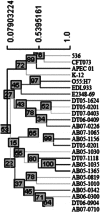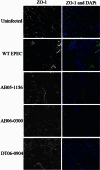Identification of potentially diarrheagenic atypical enteropathogenic Escherichia coli strains present in Canadian food animals at slaughter and in retail meats
- PMID: 23584785
- PMCID: PMC3675928
- DOI: 10.1128/AEM.00182-13
Identification of potentially diarrheagenic atypical enteropathogenic Escherichia coli strains present in Canadian food animals at slaughter and in retail meats
Abstract
This study identified and characterized enteropathogenic Escherichia coli (EPEC) in the Canadian food supply. Eighteen of 450 E. coli isolates from food animal sources were identified as atypical EPEC (aEPEC). Several of the aEPEC isolates identified in this study possessed multiple virulence genes, exhibited adherence and attaching and effacing (A/E) lesion formation, disrupted tight junctions, and were coclassified with the extraintestinal pathogenic E. coli (ExPEC) and enterotoxigenic E. coli (ETEC) pathotypes.
Figures




Similar articles
-
Host Range-Associated Clustering Based on Multilocus Variable-Number Tandem-Repeat Analysis, Phylotypes, and Virulence Genes of Atypical Enteropathogenic Escherichia coli Strains.Appl Environ Microbiol. 2019 Mar 6;85(6):e02796-18. doi: 10.1128/AEM.02796-18. Print 2019 Mar 15. Appl Environ Microbiol. 2019. PMID: 30658974 Free PMC article.
-
Extraintestinal pathogenic Escherichia coli in poultry meat products on the Finnish retail market.Acta Vet Scand. 2012 Nov 16;54(1):64. doi: 10.1186/1751-0147-54-64. Acta Vet Scand. 2012. PMID: 23158013 Free PMC article.
-
Shiga toxigenic and atypical enteropathogenic Escherichia coli in the feces and carcasses of slaughtered pigs.Foodborne Pathog Dis. 2012 Dec;9(12):1119-25. doi: 10.1089/fpd.2012.1206. Epub 2012 Nov 27. Foodborne Pathog Dis. 2012. PMID: 23186549
-
The non-O157 shiga-toxigenic (verocytotoxigenic) Escherichia coli; under-rated pathogens.Crit Rev Microbiol. 2007;33(1):67-87. doi: 10.1080/10408410601172172. Crit Rev Microbiol. 2007. PMID: 17453930 Review.
-
An overview of atypical enteropathogenic Escherichia coli.FEMS Microbiol Lett. 2009 Aug;297(2):137-49. doi: 10.1111/j.1574-6968.2009.01664.x. Epub 2009 May 27. FEMS Microbiol Lett. 2009. PMID: 19527295 Review.
Cited by
-
Diarrheagenic Escherichia coli Associated with Acute Gastroenteritis in Children from Soriano, Uruguay.Can J Infect Dis Med Microbiol. 2018 Oct 24;2018:8387218. doi: 10.1155/2018/8387218. eCollection 2018. Can J Infect Dis Med Microbiol. 2018. PMID: 30515254 Free PMC article.
-
First isolation of atypical enteropathogenic Escherichia coli from geese (Anser anser domestica) and first description of atypical EPEC from turkeys and pigeons in Hungary.BMC Vet Res. 2021 Aug 5;17(1):263. doi: 10.1186/s12917-021-02968-w. BMC Vet Res. 2021. PMID: 34353312 Free PMC article.
-
Comparative genomic analysis of a multiple antimicrobial resistant enterotoxigenic E. coli O157 lineage from Australian pigs.BMC Genomics. 2015 Mar 10;16(1):165. doi: 10.1186/s12864-015-1382-y. BMC Genomics. 2015. PMID: 25888127 Free PMC article.
-
Host Range-Associated Clustering Based on Multilocus Variable-Number Tandem-Repeat Analysis, Phylotypes, and Virulence Genes of Atypical Enteropathogenic Escherichia coli Strains.Appl Environ Microbiol. 2019 Mar 6;85(6):e02796-18. doi: 10.1128/AEM.02796-18. Print 2019 Mar 15. Appl Environ Microbiol. 2019. PMID: 30658974 Free PMC article.
-
Oral Administration of a Select Mixture of Bacillus Probiotics Affects the Gut Microbiota and Goblet Cell Function following Escherichia coli Challenge in Newly Weaned Pigs of Genotype MUC4 That Are Supposed To Be Enterotoxigenic E. coli F4ab/ac Receptor Negative.Appl Environ Microbiol. 2017 Jan 17;83(3):e02747-16. doi: 10.1128/AEM.02747-16. Print 2017 Feb 1. Appl Environ Microbiol. 2017. PMID: 27881419 Free PMC article.
References
-
- Hernandes RT, Elias WP, Vieira MA, Gomes TA. 2009. An overview of atypical enteropathogenic Escherichia coli. FEMS Microbiol. Lett. 297:137–149 - PubMed
-
- Public Health Agency of Canada 2008, posting date CIPARS 2008 — annual report. Canadian Integrated Program for Antimicrobial Resistance Surveillance (CIPARS), Public Health Agency of Canada, Guelph, Ontario, Canada: http://www.phac-aspc.gc.ca/cipars-picra/2008/index-eng.php
-
- Jakobsen L, Garneau P, Kurbasic A, Bruant G, Stegger M, Harel J, Jensen KS, Brousseau R, Hammerum AM, Frimodt-Moller N. 2011. Microarray-based detection of extended virulence and antimicrobial resistance gene profiles in phylogroup B2 Escherichia coli of human, meat and animal origin. J. Med. Microbiol. 60:1502–1511 - PubMed
Publication types
MeSH terms
Grants and funding
LinkOut - more resources
Full Text Sources
Other Literature Sources
Medical

